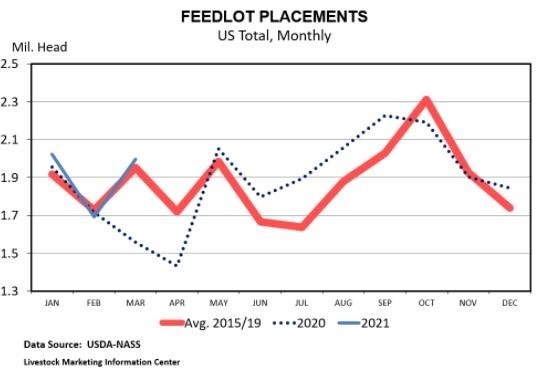By James Mitchell
Last month Kenny, Josh, and I wrote about the challenges with making year-over-year comparisons to 2020. Comparisons will be based on periods in 2020 when COVID was having major impacts on the beef sector. Last week’s highly anticipated Cattle on Feed report was the example we had in mind when we wrote that article. The Cattle on Feed (COF) report includes estimates for feedlot placements, inventory, and marketings, and each was hard to predict.

The graph above shows feedlot placements for 2021 (blue line), 2020 (dotted blue line), and the 2015-2019 average (red line). March feedlot placements totaled 1.997 million head, a 28.3 percent increase over March 2020. The cattle placement estimate is a product of two events. First, recall this time last year was when the pandemic started impacting U.S. meat supply chains. This explains why placements are large compared to the previous year. Second, 2021 March placements are likely elevated on delayed placements from February due to Winter Storm Uri. While the March placement figure seems large compared to 2020, it is only 2.4 percent above the 2015-2019 historical average.
April cattle on feed inventory total 11.897 million head, a 5.3 percent increase over April 2020. This estimate reflects some of the same COVID dynamics. Following the April-June disruptions, June-September 2020 feedlot placements averaged 10.7 percent above the 2015-2019 average. Current feedlot inventories continue to reflect high third-quarter placements from 2020.
March fed cattle marketings totaled 2.04 million head, a 1.5 percent increase over 2020. March fed cattle marketings were only slightly above 2020 despite one more slaughter day in March 2021. Again, this estimate reflects the situation experienced last year.
What does this month’s COF report mean for cattle markets? Each estimate in the COF report has implications for current and future beef production. Current feedlot inventories and only slightly higher marketings suggest that we still have large cattle supplies to move through the system. Cattle placements were below average pre-report expectations and are an indicator of future beef production. Once we work through current feedlot supplies, the continued year-over-year decline in calf crop numbers for 2020 and 2021 and high grain prices suggests a lower cattle inventory for the second half of the year. All else equal, a lower cattle inventory for the second half of 2021 will support fed cattle prices.
Source : osu.edu